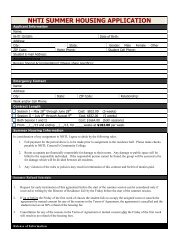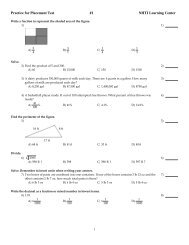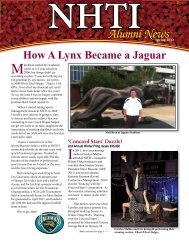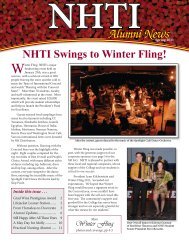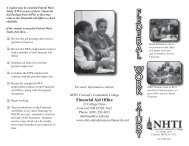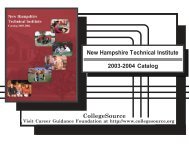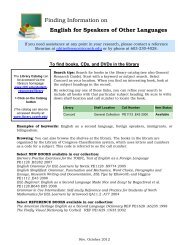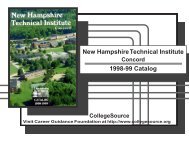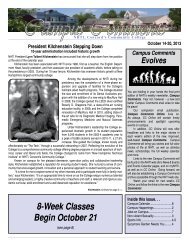Course Descriptions 11-12 - NHTI - Concord's Community College
Course Descriptions 11-12 - NHTI - Concord's Community College
Course Descriptions 11-12 - NHTI - Concord's Community College
- No tags were found...
Create successful ePaper yourself
Turn your PDF publications into a flip-book with our unique Google optimized e-Paper software.
clients. Opportunities for application of knowledge to clinicalpractice are provided through laboratory experiences andclient care assignments in various settings. Evaluation ofknowledge and clinical practice occurs throughout the coursewith interaction between the student and faculty to facilitatelearning. Clinical sites include maternal/child, pediatrics andgerontology settings. (Semester 2 Prerequisites: NU <strong>11</strong>5; EN101 and PY 105; and a minimum grade of “C” in BI 195;corequisites: BI 196 and PY 220) (Semester 3 Prerequisites:PY 220 and a minimum grade of “C” in BI 195 and BI 196;corequisites: BI 202 and MT <strong>12</strong>9 or MT <strong>12</strong>4 or MT <strong>12</strong>5 or MT251)NU <strong>11</strong>7 Nursing IIB 6-15-<strong>11</strong>The emphasis of Nursing IIB is on the care of the client withcommonly occurring health deviations related to universalself-care requirements. Focus on caring and ethical/legalstandards are continued. Using the nursing process, thestudent employs all nursing systems within the focus on theeducative/supportive and partially compensatory nursingsystems within the Self-Care Framework to assist the clientwithin a range of self-care deficits. Learning is plannedthrough concurrent classroom and clinical experiences.Opportunities for application of knowledge to practice areprovided through laboratory experiences and client careassignments in various settings. Evaluation of knowledgeoccurs throughout the course with interaction between thestudent and faculty. Clinical sites include mental health andmedical/surgical settings. (Semester 2 Prerequisites: NU<strong>11</strong>5; EN 101 and PY 105; and a minimum grade of “C” in BI195; corequisites: BI 196 and PY 220) (Semester 3Prerequisites: PY 220 and a minimum grade of “C” in BI 195and BI 196; corequisites: BI 202 and MT <strong>12</strong>9 or MT <strong>12</strong>4 or MT<strong>12</strong>5 or MT 251)NU 177 LPN-RN Advancement 2-0-2This course is designed to cover content which assists in thetransition for the LPN to the role of the registered nurse.Content includes: Dorethia Orem's self-care theory; roletransition; nursing process; teaching and learning process;therapeutic communication; ethical and legal issues innursing; and a review of fundamental nursing skills. Studentsare required to have an active LPN license and have met thestated admission requirements. (Prerequisites: Admission tothe LPN-RN Advancement Option, including successfulcompletion the NLN Acceleration Challenge Exam I;corequisites: BI 195, EN 101 and PY 105)NU 215 Nursing III 4-15-9Nursing III builds on principles and concepts from thediscipline of nursing, the biopsychosocial sciences and liberalarts. The emphasis of Nursing III is on the current trends innursing and on the comprehensive care of the client withhealth deviations requiring the wholly compensatory nursingsystem. The student establishes caring relationships andadheres to ethical/legal standards of nursing practice. Thestudent uses the nursing process to design, provide, manageand evaluate care for the client with commonly occurringhealth deviations. Learning is planned through concurrentclassroom and clinical experiences. Opportunities forapplication of knowledge to practice are provided throughlaboratory experiences and client care assignments in varioussettings. Evaluation of knowledge and clinical practice occursthroughout the course with interaction between the studentand faculty. Clinical sites are in medical/surgical settings.(Prerequisites: NU <strong>11</strong>6, NU <strong>11</strong>7 and a grade of “C” or higherin MT <strong>12</strong>9 or MT <strong>12</strong>4 or MT <strong>12</strong>5 or MT 251; Corequisites: ENxxx, IT 102 and PI 242)Orthopaedic TechnologyORTH 101 Orthopaedic Anatomy & Physiology I 3-0-3This course is an introduction to the anatomy and physiologyof the musculoskeletal system and related structures.Attention will be directed toward structural make-up, groupcomposition, relationships, and location of each bone.Common fractures and treatments will be discussed in detail.Also covered will be normal and abnormal growth anddevelopment and the response to injury and disease, as wellas the response of related structures to the mechanisms ofinjury and disease.ORTH 102 Orthopaedic Anatomy and Physiology II 3-0-3This course is a continuation of Orthopaedic Anatomy &Physiology I with a focus on common orthopaedic injuriesand conditions of muscles, ligaments, tendons, and nerves,and their treatments. Also covered will be the disruption tocontinuity to the musculoskeletal system and relatedstructures resulting from congenital, emergent, oropportunistic diseases and trauma and their treatments.(Prerequisite: ORTH 101)ORTH 103 Basic Radiology Interpretation 3-0-3This course will cover the history of radiology, and gives thestudent the basics of radiographic image production.Students will be introduced to the viewing and interpretationof plain orthopaedic radiographs, MRI's, and other types ofpermanent imaging relating to orthopaedics, terminologyrelating directly to the skeletal system and fracture healing,and describing a fracture as it relates to the radiographicimage.ORTH 104 Physical Assessment of the Orthopaedic Patient3-2-4A comprehensive course that provides integration ofknowledge and terminology utilized for orthopaedic patientphysical assessment. Included are life span differences andassessment of acute and chronic patient orthopaedicproblems. Lab time covering the application and use ofvarious orthopaedic devices, their complications, andcontraindications is an intrinsic part of this course, allowingstudents hands-on experience with these products. Studentswill learn how to do custom measurements along with bracefitting techniques. Braces will be matched up with theircommonly used diagnoses for better conceptualunderstanding of how these devices affect patient outcomes.Medical coding and reimbursement procedures will also bediscussed. (Prerequisites: ORTH 101, ORTH 103, ORTH 105,and ORTH 107)ORTH 105 Casting and Splinting I 2-2-3This area is an integral part of the practice of an orthopaedictechnologist. Topics to be covered will include the types,application, functions, and materials of the various casts andsplints, as well as basic terminology related to the subject.8/17/20<strong>11</strong> <strong>NHTI</strong>, Concord’s <strong>Community</strong> <strong>College</strong> <strong>Course</strong> <strong>Descriptions</strong> 20<strong>11</strong>-20<strong>12</strong> 45



